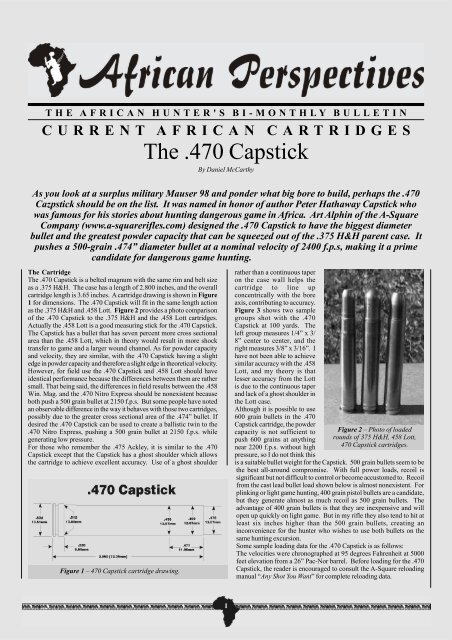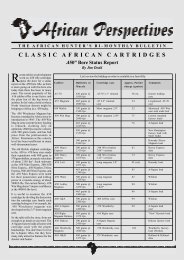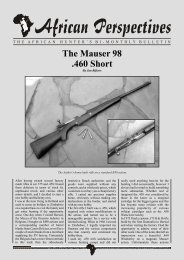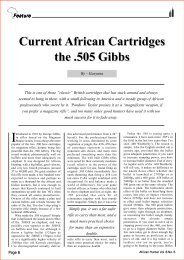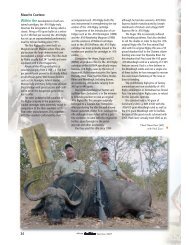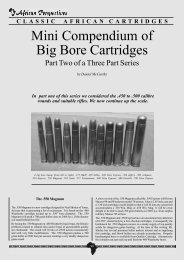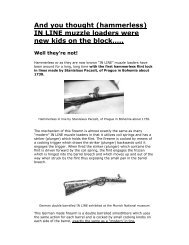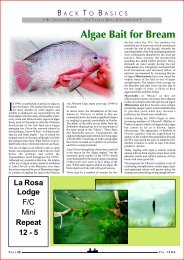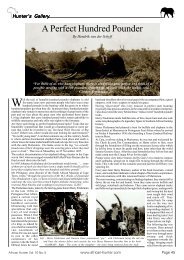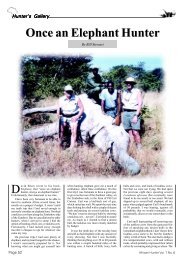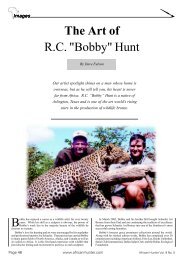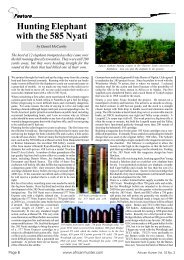The .470 Capstick - HuntNetwork
The .470 Capstick - HuntNetwork
The .470 Capstick - HuntNetwork
Create successful ePaper yourself
Turn your PDF publications into a flip-book with our unique Google optimized e-Paper software.
THE AFRICAN HUNTER'S BI-MONTHLY BULLETIN<br />
CURRENT AFRICAN CARTRIDGES<br />
<strong>The</strong> <strong>.470</strong> <strong>Capstick</strong><br />
By Daniel McCarthy<br />
As you look at a surplus military Mauser 98 and ponder what big bore to build, perhaps the <strong>.470</strong><br />
Cazpstick should be on the list. It was named in honor of author Peter Hathaway <strong>Capstick</strong> who<br />
was famous for his stories about hunting dangerous game in Africa. Art Alphin of the A-Square<br />
Company (www.a-squarerifles.com) designed the <strong>.470</strong> <strong>Capstick</strong> to have the biggest diameter<br />
bullet and the greatest powder capacity that can be squeezed out of the .375 H&H parent case. It<br />
pushes a 500-grain .474” diameter bullet at a nominal velocity of 2400 f.p.s, making it a prime<br />
candidate for dangerous game hunting.<br />
<strong>The</strong> Cartridge<br />
<strong>The</strong> <strong>.470</strong> <strong>Capstick</strong> is a belted magnum with the same rim and belt size<br />
as a .375 H&H. <strong>The</strong> case has a length of 2.800 inches, and the overall<br />
cartridge length is 3.65 inches. A cartridge drawing is shown in Figure<br />
1 for dimensions. <strong>The</strong> <strong>.470</strong> <strong>Capstick</strong> will fit in the same length action<br />
as the .375 H&H and .458 Lott. Figure 2 provides a photo comparison<br />
of the <strong>.470</strong> <strong>Capstick</strong> to the .375 H&H and the .458 Lott cartridges.<br />
Actually the .458 Lott is a good measuring stick for the <strong>.470</strong> <strong>Capstick</strong>.<br />
<strong>The</strong> <strong>Capstick</strong> has a bullet that has seven percent more cross sectional<br />
area than the .458 Lott, which in theory would result in more shock<br />
transfer to game and a larger wound channel. As for powder capacity<br />
and velocity, they are similar, with the <strong>.470</strong> <strong>Capstick</strong> having a slight<br />
edge in powder capacity and therefore a slight edge in theoretical velocity.<br />
However, for field use the <strong>.470</strong> <strong>Capstick</strong> and .458 Lott should have<br />
identical performance because the differences between them are rather<br />
small. That being said, the differences in field results between the .458<br />
Win. Mag. and the <strong>.470</strong> Nitro Express should be nonexistent because<br />
both push a 500 grain bullet at 2150 f.p.s. But some people have noted<br />
an observable difference in the way it behaves with those two cartridges,<br />
possibly due to the greater cross sectional area of the .474” bullet. If<br />
desired the <strong>.470</strong> <strong>Capstick</strong> can be used to create a ballistic twin to the<br />
<strong>.470</strong> Nitro Express, pushing a 500 grain bullet at 2150 f.p.s. while<br />
generating low pressure.<br />
For those who remember the .475 Ackley, it is similar to the <strong>.470</strong><br />
<strong>Capstick</strong> except that the <strong>Capstick</strong> has a ghost shoulder which allows<br />
the cartridge to achieve excellent accuracy. Use of a ghost shoulder<br />
Figure 1 – 470 <strong>Capstick</strong> cartridge drawing.<br />
I<br />
rather than a continuous taper<br />
on the case wall helps the<br />
cartridge to line up<br />
concentrically with the bore<br />
axis, contributing to accuracy.<br />
Figure 3 shows two sample<br />
groups shot with the <strong>.470</strong><br />
<strong>Capstick</strong> at 100 yards. <strong>The</strong><br />
left group measures 1/4” x 3/<br />
8” center to center, and the<br />
right measures 3/8” x 3/16”. I<br />
have not been able to achieve<br />
similar accuracy with the .458<br />
Lott, and my theory is that<br />
lesser accuracy from the Lott<br />
is due to the continuous taper<br />
and lack of a ghost shoulder in<br />
the Lott case.<br />
Although it is possible to use<br />
600 grain bullets in the <strong>.470</strong><br />
<strong>Capstick</strong> cartridge, the powder<br />
capacity is not sufficient to<br />
push 600 grains at anything<br />
near 2200 f.p.s. without high<br />
pressure, so I do not think this<br />
Figure 2 – Photo of loaded<br />
rounds of 375 H&H, 458 Lott,<br />
470 <strong>Capstick</strong> cartridges.<br />
is a suitable bullet weight for the <strong>Capstick</strong>. 500 grain bullets seem to be<br />
the best all-around compromise. With full power loads, recoil is<br />
significant but not difficult to control or become accustomed to. Recoil<br />
from the cast lead bullet load shown below is almost nonexistent. For<br />
plinking or light game hunting, 400 grain pistol bullets are a candidate,<br />
but they generate almost as much recoil as 500 grain bullets. <strong>The</strong><br />
advantage of 400 grain bullets is that they are inexpensive and will<br />
open up quickly on light game. But in my rifle they also tend to hit at<br />
least six inches higher than the 500 grain bullets, creating an<br />
inconvenience for the hunter who wishes to use both bullets on the<br />
same hunting excursion.<br />
Some sample loading data for the <strong>.470</strong> <strong>Capstick</strong> is as follows:<br />
<strong>The</strong> velocities were chronographed at 95 degrees Fahrenheit at 5000<br />
feet elevation from a 26” Pac-Nor barrel. Before loading for the <strong>.470</strong><br />
<strong>Capstick</strong>, the reader is encouraged to consult the A-Square reloading<br />
manual “Any Shot You Want” for complete reloading data.
CURRENT AFRICAN CARTRIDGES<br />
<strong>The</strong> Rifles.<br />
Currently factory rifles in <strong>.470</strong> <strong>Capstick</strong> are available from A-Square,<br />
from the Winchester Custom Shop and from Fuchs Fine Guns<br />
(www.jagdwaffe.com). However, that short list should not disappoint<br />
the reader because there are many options for building a nice custom<br />
rifle in <strong>.470</strong> <strong>Capstick</strong>. Any action that can handle the .375 H&H is a<br />
suitable candidate.<br />
<strong>The</strong> easiest conversion is a CZ550 that came from the factory in .375<br />
H&H, .458 Win. Mag or .458 Lott. All that has to be done is to replace<br />
the barrel with another in <strong>.470</strong> <strong>Capstick</strong>. Barrels are available from<br />
Lothar-Walther (www.lothar-walther.de) and Pac-Nor (www.pacnor.com).<br />
A second recoil lug must be added to the underside of the<br />
barrel and inletted into the forearm of the stock. <strong>The</strong> second recoil lug<br />
will spread recoil that the stock is exposed to across a wider surface<br />
area to avoid splitting the stock. Glass or steel bedding is recommended.<br />
Some minor polishing or adjusting of the ramp and rails may be needed,<br />
and then the rifle is ready to shoot. <strong>The</strong> advantage of the CZ550<br />
conversion is that they typically hold five rounds in the magazine box<br />
plus one in the chamber, and very little work is typically needed to get<br />
them to feed.<br />
A Winchester Model 70 Classic (claw extractor) can also easily be<br />
converted to <strong>.470</strong> <strong>Capstick</strong>. In addition to the steps above, the magazine<br />
box spring must also be replaced with one that has a traditional Zshape<br />
instead of the curly-Q style that the factory provides. <strong>The</strong><br />
Winchester<br />
conversion may only<br />
hold two cartridges in<br />
the magazine box<br />
unless you purchase<br />
an extra deep<br />
magazine box and<br />
bottom metal from<br />
Sunny Hill (through<br />
www.brownells.com),<br />
Williams Firearms<br />
( h t t p : /<br />
www.williamsfirearms.com/<br />
) Jim Wisner (http://<br />
www.wisnersinc.com/)<br />
or Ted Blackburn (801<br />
Figure 3 – Target with two different three<br />
shot groups fired from a 470 <strong>Capstick</strong> rifle<br />
at 100 yards. <strong>The</strong> left group of three was<br />
shot using 500-grain Woodleigh soft points<br />
on top of 90.0 grains of Reloader 15<br />
powder. <strong>The</strong> right group of three was shot<br />
using 500-grain Woodleigh soft points on<br />
top of 85 grains of IMR 4064 powder. This<br />
kind of accuracy can be attributed to fine<br />
gunsmithing and to the ghost shoulder on<br />
the <strong>.470</strong> <strong>Capstick</strong>, which helps to center the<br />
cartridge in the chamber and leads to an<br />
inherently accurate cartridge.<br />
373 3526). Use of an<br />
extra deep magazine<br />
box necessitates<br />
replacement of the<br />
stock with another<br />
stock having greater<br />
depth of wood.<br />
Alternatively, it may<br />
be possible to fit three<br />
rounds in a model 70<br />
conversion with the<br />
factory magazine box<br />
if the follower is<br />
replaced with one<br />
II<br />
having a lower profile, or if the follower is milled to shorten it.<br />
Another option, and the one which I prefer, is to rebuild a surplus<br />
military Mauser 98 action to be a <strong>.470</strong> <strong>Capstick</strong> dangerous game rifle.<br />
This is a very involved project and includes replacing the magazine box<br />
bottom metal, spring and follower and opening up the receiver to match<br />
it. Further, some machining of the new magazine box may be needed<br />
since no one makes a magazine box expressly intended to hold four<br />
rounds of <strong>.470</strong> <strong>Capstick</strong>. Proper feeding is not easy to accomplish and<br />
requires a big bore expert such as Dennis Olson of Plains, Montana to<br />
radically modify the rails and ramp. A picture of a Mauser 98 in <strong>.470</strong><br />
<strong>Capstick</strong> is shown in Figure 4. <strong>The</strong> stepped configuration of the feed<br />
rails of that rifle is shown in Figure 5. <strong>The</strong> stepped feed rails plus a<br />
modified feed ramp achieve smooth feeding of flat nosed<br />
solid bullets in this rifle.<br />
Any of these routes can result in a very functional and very<br />
accurate dangerous game rifle. <strong>The</strong> author’s personal<br />
preference of a Mauser 98 action is not the route for persons<br />
seeking a budget-oriented rifle or for persons who do not<br />
have access to a gunsmith who is a genuine big bore expert.<br />
Frankly speaking, there are not a lot of gunsmiths who know<br />
how to get a big bore to feed properly, making the CZ550<br />
conversion very attractive because there is so little to do.<br />
In the Field<br />
<strong>The</strong> <strong>.470</strong> <strong>Capstick</strong> is designed for use as a dangerous game<br />
cartridge, but it has proven very useful on light game as well.<br />
<strong>The</strong> key is to select a bullet suitable for the game. If a bullet<br />
designed for use on Cape buffalo is used on whitetails, it undoubtedly<br />
will not expand. For light game, Hawk bullets which expand quickly or<br />
400 grain pistol bullets may be best. When the <strong>.470</strong> <strong>Capstick</strong> is loaded<br />
with a 500 grain bullet to a muzzle velocity of 2300 f.p.s. and sighted<br />
in three inches high at 100 yards, it is only about a foot low at 300<br />
yards, giving it more effective range than many cartridges which are<br />
popular for deer and elk hunting. I have lobbed <strong>.470</strong> <strong>Capstick</strong> bullets<br />
into game at that range, so it cannot be too difficult.<br />
Another consideration in choosing a bullet for hunting is the velocity<br />
window of the bullet. For example, the 500 grain Woodleigh soft point<br />
Figure 4 – Surplus military Mauser 98 action (1940) built into a<br />
470 <strong>Capstick</strong> rifle.<br />
Figure 5 – Feed rails of Mauser 98 rebuilt to feed 470 <strong>Capstick</strong>. Note<br />
the stepped configuration of the feed rails, which when combined with<br />
modifications to the feed ramp, facilitate feeding of flat nosed solid<br />
bullets.<br />
is designed to expand at <strong>.470</strong> Nitro Express velocities (2150 f.ps.), and<br />
if pushed to the 2400 f.p.s. potential of the <strong>.470</strong> <strong>Capstick</strong>, the Woodleigh<br />
will tend to expand very quickly and sacrifice penetration. Figure 6
CURRENT AFRICAN CARTRIDGES<br />
shows a 500 grain Woodleigh soft nose fired from a <strong>.470</strong> <strong>Capstick</strong> into<br />
a kudu at less than 20 yards with about 2350 f.p.s muzzle velocity.<br />
<strong>The</strong> recovered bullet weighed exactly 400 grains and measured 1.02”x<br />
0.72”. <strong>The</strong> Woodleigh soft nose was designed to expand at the lower<br />
velocities of the <strong>.470</strong> Nitro Express, and the fact that it held together at<br />
all in the <strong>.470</strong><br />
<strong>Capstick</strong> is<br />
testimony to<br />
the Woodleigh’s<br />
toughness.<br />
Penetration was<br />
just over three<br />
feet.<br />
<strong>The</strong> author’s<br />
favorite .474”<br />
bullet, the 500<br />
grain GS<br />
Custom flat<br />
nosed solid,<br />
penetrated<br />
through the<br />
elephant<br />
shoulder and<br />
reached more<br />
than six feet into<br />
the elephant<br />
b e f o r e<br />
stopping.<br />
Figure 6 – Expanded Woodleigh 500-grain soft nose<br />
bullet fired from 470 <strong>Capstick</strong> into a kudu at less<br />
than 20 yards at about 2350<br />
Muzzle velocity was just over 2300 f.p.s. and the bullet was not<br />
defornmed when recovered (see Figure 7). This is first class<br />
performance, but many of the other bullets discussed below are excellent<br />
choices as well. Among solids, in general the flat nosed designs will<br />
typically transfer more shock to the animal, penetrate more deeply,<br />
and cut a cleaner hole in the animal for more rapid bleed out compared<br />
to round nose bullets.<br />
Bullets, Etc.<br />
<strong>The</strong>re are many bullets available that can be used in the <strong>.470</strong> <strong>Capstick</strong>,<br />
as shown in the table.<br />
Previously, Bridger Bullets offered exceptionally accurate brass flat<br />
nosed solids in .474” diameter, but they are no longer in production.<br />
However, the basic design could be replicated by someone with an<br />
appropriate lathe and half-hard brass bar stock.<br />
It is also noteworthy that the driving band bullet designs, such as GS<br />
Custom, North Fork and Bridger, engrave on the rifling with very little<br />
III<br />
Figure 7 –<br />
Recovered 500 grain<br />
GS Custom flat<br />
nosed solid<br />
recovered from an<br />
elephant after being<br />
fired from a 470<br />
<strong>Capstick</strong> at just over<br />
2300 f.p.s. <strong>The</strong><br />
pressure, allowing them<br />
to be loaded with a<br />
greater powder charge<br />
for greater peak<br />
velocity. <strong>The</strong> other<br />
benefit of this design is<br />
that it does not tend to<br />
foul the barrel, in<br />
contrast with the Barnes<br />
X-bullet, Trophy<br />
Bonded Bearclaw, and<br />
Swift A-Frame which<br />
foul some barrels very<br />
quickly.<br />
Cases for the <strong>.470</strong><br />
<strong>Capstick</strong> are available<br />
from a variety of<br />
sources. Properly<br />
headstamped brass can<br />
be purchased from Huntingtons (www.huntingtons.com), A-Square,<br />
Quality Cartridge (http://owlnet.com/quality/) and Dieter Horneber (http:/<br />
/www.huelsen-horneber.de/). Or .375 cylindrical brass can be used<br />
Figure 8 – Some of the bullets available for the 470 <strong>Capstick</strong>, from left<br />
to right: 500 grain Woodleigh soft point, 500 grain Woodleigh solid,<br />
500 grain Trophy Bonded Bearclaw softpoint, 500 grain Trophy<br />
Bonded Sledgehammer solid, 500 grain GS Custom flat nosed solid<br />
(the author’s favorite), 500 grain North Fork flat nosed solid (prototype),<br />
550 grain Bridger flat nosed solid, 500 grain Barnes solid, 600 grain<br />
Barnes soft nose, 500 grain Hawk soft point, 500 grain cast lead, 400<br />
(available from Huntingtons). Alternativey the reloader can fireform<br />
his own brass from .375 H&H, .416 Remington or .458 Lott brass.<br />
Dies for the <strong>.470</strong> <strong>Capstick</strong> may be purchased from Redding<br />
(www.reddingreloading.com), RCBS (www.rcbs.com) or CH4D<br />
(www.ch4d.com). And for the shooter desiring factory ammunition, A-<br />
Square, Superior Ammo (www.superiorammo.com), Safari Arms<br />
(www.safariarms.com) and Quality Cartridge support the <strong>.470</strong> <strong>Capstick</strong><br />
with dangerous game ammo.<br />
Conclusion<br />
For those who like the road less traveled, the <strong>.470</strong> <strong>Capstick</strong> may be a<br />
nice alternative to some of the more mundane factory big bore offerings.<br />
It can be used to duplicate either the <strong>.470</strong> Nitro Express or the .458<br />
Lott, but offers greater frontal cross sectional area than the .458 Lott.<br />
Accuracy with the cartridge is excellent, and an inexpensive six shot<br />
repeater can be made from the CZ550 in a simple rebarreling project.<br />
Alternatively, a Model 70 or a Mauser 98 can be the basis of a <strong>.470</strong><br />
<strong>Capstick</strong> rifle. <strong>The</strong> trajectory of this cartridge is better than you may<br />
expect, and the field performance is excellent. It may be worth a<br />
look.<br />
“WARNING - Hand loading is potentially dangerous - <strong>The</strong> loading<br />
data and methods contained in this article are offered as a<br />
reference only, and relates to an individual’s weapon and<br />
experience. While it may be safe in that weapon, it may not be in<br />
others. Neither the author, nor Publishers are responsible for<br />
the use or abuse of this data, or the consequences thereof.”


